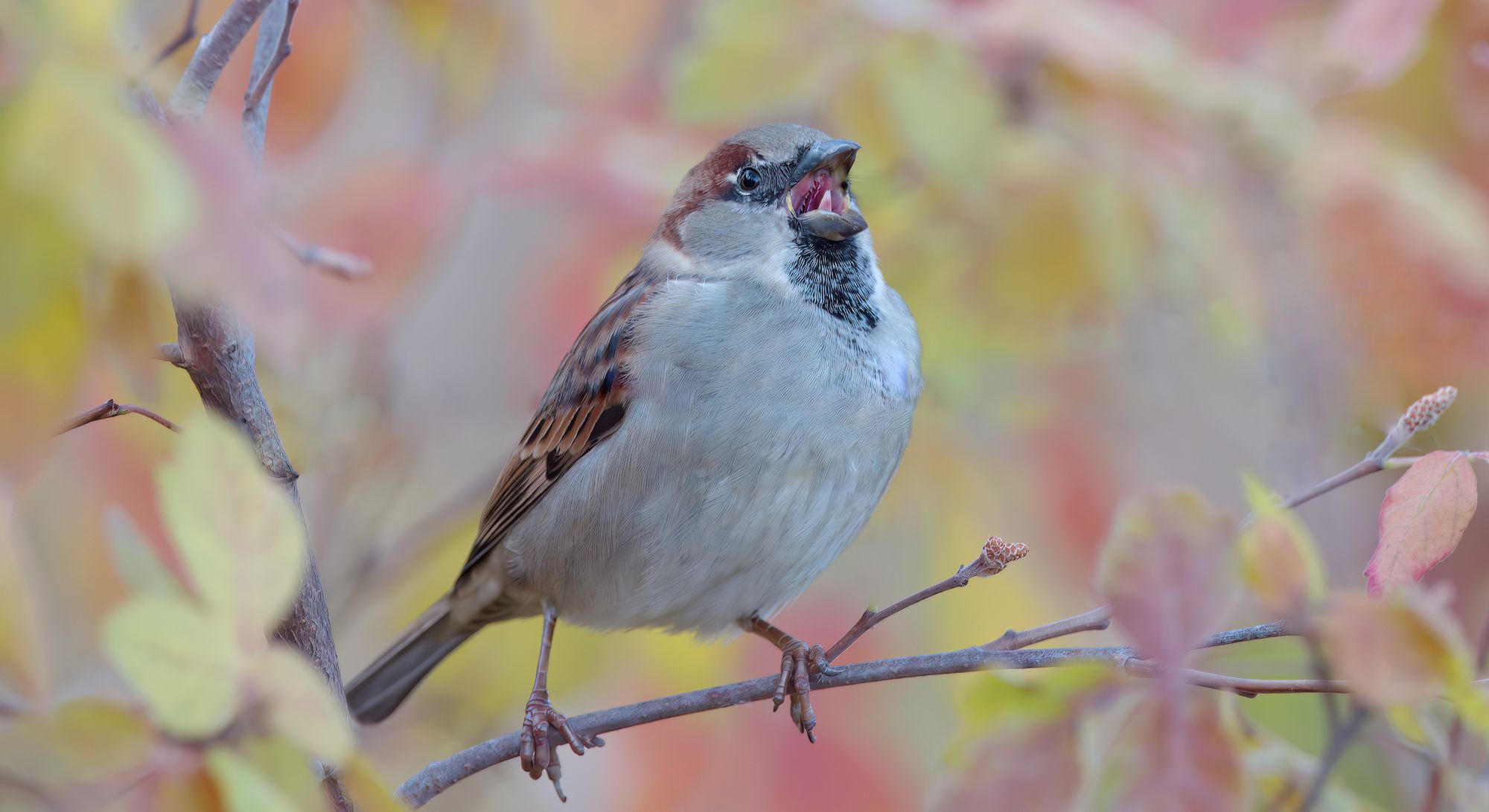House Sparrow

In most (if not all) cities, this noisy bird is a hard one to miss. House Sparrows were introduced to North America sometime during the 20th century, and have managed to adapt very well to our urban environments.
While it may be common, this species is also probably the most controversial. From one side, they deserve some credit for being able to adapt to the harsh conditions in the city, and (as I explain below) they have unique social and feeding habits. But their introduction has caused significant problems for native North American bird populations, which has earned them a reputation as a serious pest.
Appetite for Anything

In the Spring of 2022, the pink petals on this Sweet Crabapple tree went into full bloom. After grabbing my camera and heading outside, I was surprised to see House Sparrows and Blue Jays swarming the tree, devouring the fresh flower buds.

This House Sparrow seemed really interested in the berries on this privet bush, and its pose made for a photo opportuntity that was just too good to pass up.
House Sparrows will eat just about anything, whether natural or man-made. They will take advantage of seeds, berries, insects, and even crumbs from baked goods.
Research has also shown that, in order to adjust to the human environment, House Sparrows have adapted physically over time. In a study3 published by the Royal Society, researchers found that, as they moved into cities, House Sparrows developed thicker beaks and their bodies increased the production of amylase (an enzyme that breaks down starch). The thicker beaks allowed House Sparrows to take advantage of non-natural food sources (like grains with thick protective layers4), and the increase in amylase production has helped humans digest starchier foods6,7 (so according to the researchers, the same probably applies to the sparrows).
It might also be the case that House Sparrows will quickly identify new sources of food if placed outside of their native range. In one study 1, researchers captured two groups of sparrows: One group was taken from another part of the world, and another group was captured in an area close to where the researchers lived. The researchers then provided "unusual" foods to both groups, and measured how fast it would take for each group to eat the new food. In the end, results consistently showed that the "non-native" group started to eat the new foods much quicker than the local group.
Social...Butterflies?

"The Business Meeting"
Many years ago, there was a feeder outside of our house that proved very popular with the local House Sparrows. They would gather in large groups on the mulberry and yew bushes in the backyard, and visit the feeders a few at a time. When in a group, they would always talk to each other, like a well-organized unit coming up with a plan.

House Sparrows may work well in a group. But when it comes to food, they mean business. I think this photo does a good job of demonstrating that.
House Sparrows are highly social birds: They live their lives in flocks, which are led by the male with the biggest black patch 5. As the leader, the dominant male gets access to quite a few perks, such as having access to better food and better mates.
Studies have also shown that House Sparrows, like humans, have the ability to learn faster when working in groups. In one study 2, researchers placed House Sparrows in a new environment, where they were either paired with a flock member or non-flock member, or left alone entirely. The study was able to conclude that female House Sparrows were quickest to explore new places when placed with a member of their own flock, and that male house sparrows were quicker to explore new areas when paired with another sparrow. But when left alone, it took significantly longer for male and female House Sparrows to explore their new environment.
Sources:
[1]: A taste for novelty in invading house sparrows, Passer domesticus
https://doi.org/10.1093/beheco/ari044
[2]: House sparrows’ (Passer domesticus) behaviour in a novel environment is modulated by social context and familiarity in a sex-specific manner
https://doi.org/10.1186/s12983-018-0267-8
[3]: Signatures of human-commensalism in the house sparrow genome
https://royalsocietypublishing.org/doi/10.1098/rspb.2018.1246#d1e1293
[4]: Beak and skull shapes of human commensal and non-commensal house sparrows Passer domesticus
https://bmcecolevol.biomedcentral.com/articles/10.1186/1471-2148-13-200#Sec2
[5]: The House Sparrow: Little Troopers
https://www.audubon.org/news/the-house-sparrow
[6]: Changes in brain gene expression during migration in the white-crowned sparrow
https://www.sciencedirect.com/science/article/abs/pii/S036192300800141X?via%3Dihub
[7]: Diet and the evolution of human amylase gene copy number variation
https://www.nature.com/articles/ng2123